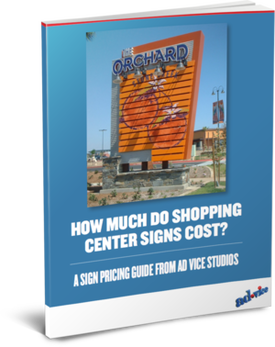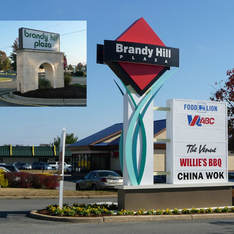|
Check out our progress on two pylons (50 ft. and 35 ft.) for Kimco at their Dania Pointe mixed-use development in Florida. Let us know what you think.
0 Comments

By its nature, the commercial sign-making process does not enjoy a simple timetable. Every sign is different and so are the circumstances that surround its journey from concept to installation.
For a new pylon sign, the complete process from initial consultation to installation should take a minimum of 12 weeks. The process takes longer for more complex projects with more extensive sign needs. For instance, a shopping center project with multiple items, such as monument signs, pylon signs, wayfaring street signs, and directories, could require 20-22 weeks, at least. As you can see, your sign’s development needs to be prioritized so ensure it meets your deadline. The sign-making process includes distinct stages, and each is critical to creating the sign that you want – and ensuring it’s ready when you need it. Initial consultation At the outset, your company will meet with designers to discuss the sign or signs that are needed. It is important to attend this first meeting with a clear idea of the objectives, scope and budget range for your project. The more clearly you are able to articulate the purpose of the sign, the better the designers will be able to serve as valuable consultants at the outset. In addition, clear objectives from the start can help lay the path for a smoother design, permitting, and fabrication and installation experience. Working with a sign-making business such as Ad Vice that offers comprehensive services – able to guide you through every step of the process – can help you avoid costly wrong turns. From that initial consultation, the sign designers will detail their projected budget and schedule and you can determine if the partnership is a good fit. 
The commercial sign market has experienced a watershed shift in the use of one of a sign’s crucial components. Fluorescent bulbs long were the favored technology for giving signs their glow, but LED bulbs have emerged in recent years as a preferred choice for many sign-makers and their customers.
Newly fabricated signs now often are installed with LED bulbs, including most signs designed and fabricated by Ad Vice Studios. In addition, shopping center operators and others increasingly are weighing the value of retrofitting their existing signs with new LED bulbs. Ad Vice, for instance, has seen a surge in retrofit requests. A LED retrofit comes at an upfront cost. The ballast, trays and electronics must be replaced, along with the bulbs. However, LED bulbs provide an array of key advantages that often make a retrofit an attractive option that is well worth the investment. If you are wondering whether a retrofit is right for you, here are some of the critical benefits to consider. Get our Sign Pricing Guide - Real projects, real pricing Whether you’re developing a new property or renovating the signs at an existing one, the cost will be an important consideration. How much should you budget for new signs? What can I get for the amount that I’ve already budgeted? Our Sign Pricing Guide was created to help answer these and other questions related to custom sign development. Pricing information for pylons, monuments, directories and way finding signs Factors that determine sign cost Alternative materials that may save you moneySign cost vs. other advertising options Download your copy now!  Your friends at Ad Vice Studios just want to remind you to use this week to make sure your light timers and digital message boards are ready for the time change on Sunday, March 11 at 2 am. That's easier to do than to reset the clock on the stove! More daylight means more visitors will see your signs, so be sure to make them shine. You may also want to replace any burned out bulbs and freshen up the landscaping around your signs. All this talk about Daylight Savings Time made us curious about why we do this anyway. Here's what we found. Daylight saving time 2018: 7 myths and facts about changing the clock (bigthink.com) Happy holidays from all of us at Ad Vice Studios. Having the opportunity to support your signage needs in 2017 has been an honor. We thank you for your continued support and look forward to serving you again in 2018.
Protect your company’s investment with these five ideas for making a great first impression. 
Contrary to what you may read, the retail industry is not dying, but it has become harder than ever to get customers to put down their phones and computers and pay a visit to our locations.
People want to shop in places that look inviting, fun, safe, and have an appealing tenant mix of both quality stores and, if the location merits it, solid dining options. Therefore, it is crucial to maintain the appearance of your property from storefront to the street. When properties are neglected, they can contribute to neighborhood decline, lower property values, and even crime. When shoppers are given a welcoming, enjoyable environment, they stick around longer – and hopefully spend more. Depending on the age of your shopping center, it may be time to consider upgrading the appearance. Here are five ways to do so.
You’ve got a lot of competition, online and offline. Create new reasons for your customers to visit your center.

In a world that becomes more digitally oriented every day, operating a brick-and-mortar retail location can seem daunting. There’s no denying that online shopping has increased in recent years, but according to a recent Pew Research Center survey, 64 percent of Americans still prefer to buy from a physical store, and RetailNext pegs 94 percent of all retail sales stemming from a store.
Still, with the majority of Americans believing they can find a better deal online, it’s important as a property manager to get creative in finding ways to get new feet onto your property. You can do that by creating engaging experiences that shoppers can’t get on the web. So if that guy you paid to dance on the side of the road spinning a sign scared away as many people as he brought in, here are a few other ideas to try.
Do your homework or risk major delays to your sign approval. 
When I started in the commercial signage business 27 years ago, we could walk into a city or county permitting office and, 15 minutes later, leave with an approved sign permit.
These days, if you choose to wait, you’ll be sitting in that same office for about five weeks on average. I love everything about the signage business, but after nearly three decades, the most challenging part remains the permitting process. Regulations have become more challenging, establishing overall height, setbacks from the street and nearby structures, square footage allowances for text, distance between signs, and the number of signs that a property is allowed to have. Rules and regulations – which vary depending on whether it's a commercial, industrial, or residential zone – are done in the name of keeping a pleasant aesthetic to streetscapes and skylines (although beauty is in the eye of the beholder) and, perhaps more nobly, ensures displays don’t impede right of way and keeps people safe (which we support). In an otherwise two-party, commercial transaction between sign designer/installer and property, the involvement of government bureaucracy can quickly slow down business. And sometimes, these stringent regulations can kill a project altogether. Here are eight tips I’ve learned over the years to get through it as fast as possible and keep your project on track. |
Ad Vice StudiosDavid Goodwin is the president of Ad Vice Studios, a Richmond, Va-based marketing services company. David has built his career and his business collaborating with property managers, developers and architects to transform commercial properties into attractive destinations with unique brands and customer experiences. Archives
August 2018
Categories
All
|



 RSS Feed
RSS Feed